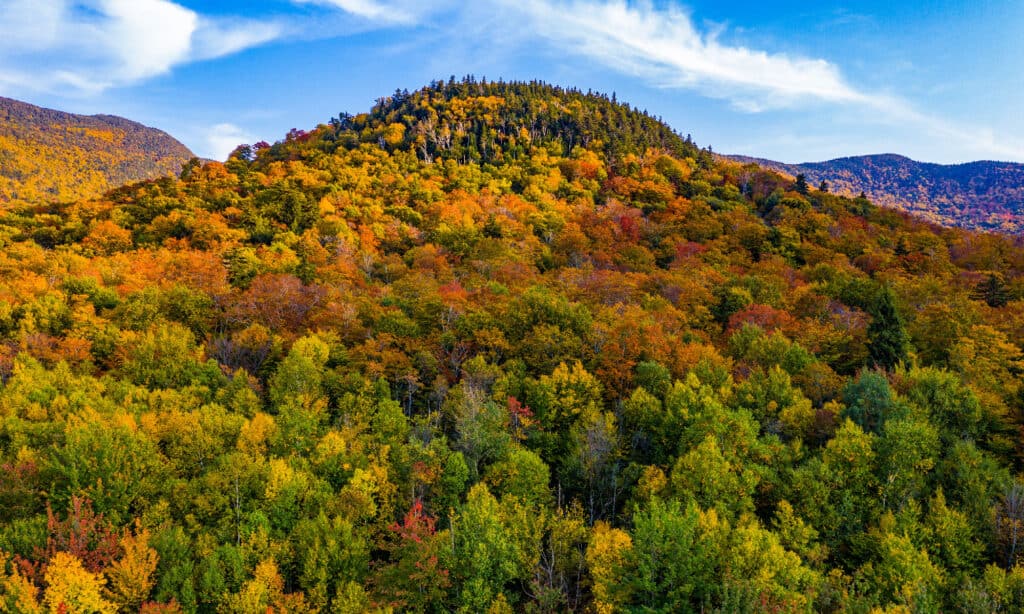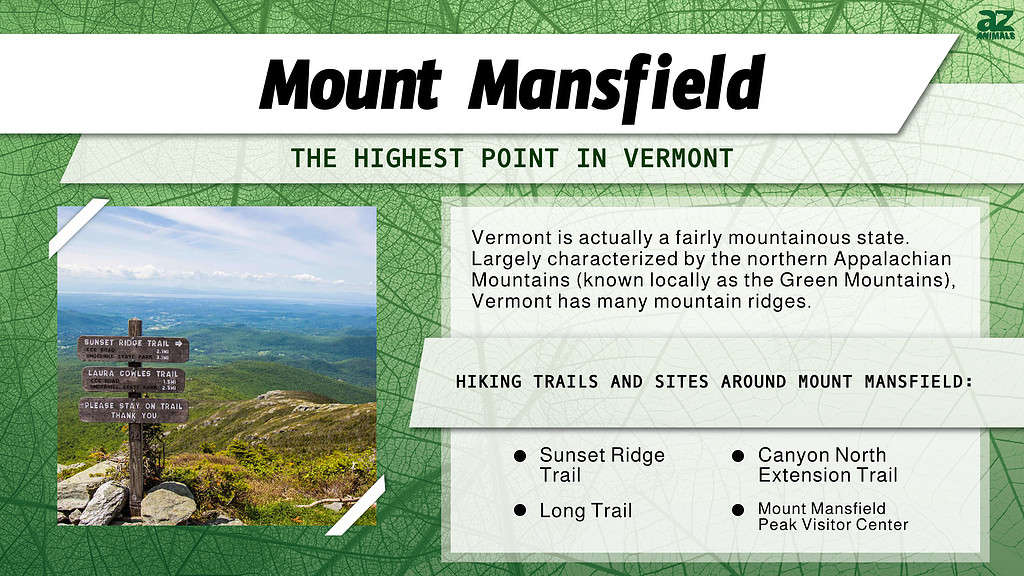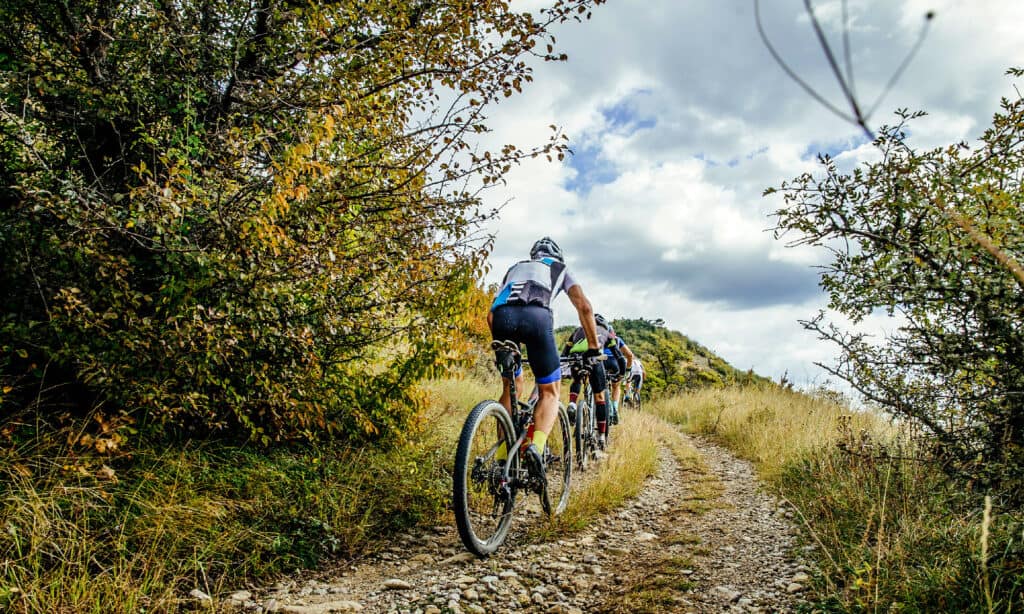Vermont is the only New England state that doesn’t touch the Atlantic Ocean. This northerly, forested land borders Canada in the north and has fewer than 700,000 inhabitants. The only state with fewer people is Wyoming. A popular destination for leaf “peepers” in the fall, Vermont is home to miles of woods filled with white-tail deer, black bear, turkey, and more. For outdoor enthusiasts, there are plenty of activities to choose from, including skiing, hiking, and camping. But, just how high is the highest point in Vermont?
Here, we’ll discover Vermont’s highest point, as well as the other top four contenders. We’ll find out what there is to do at the high point, and how to get there. Finally, we’ll discover how the highest point in Vermont compares to the elevations of the rest of the state.
The Highest Spot In Vermont

The highest point in Vermont is Mount Mansfield.
©Felix Lipov/Shutterstock.com
Mount Mansfield is the highest point in Vermont, with an elevation of 4,393 feet (1,339 meters). Located in the state’s northern half, almost directly east of Burlington, this peak lies entirely within the Mount Mansfield State Forest. Interestingly, Mount Mansfield’s summit ridge features some of the only surviving alpine tundras in the state ( a holdover from the most recent ice age). Technically, the University of Vermont owns the majority of the summit ridge, though this ownership does not impede public access to the peak.

What about the Rest of Vermont?
It might surprise you, but Vermont is actually a fairly mountainous state. Largely characterized by the northern Appalachian Mountains (known locally as the Green Mountains), Vermont has many mountain ridges. In fact, 31 of the state’s peaks exceed 3,500 feet in elevation. Even so, the average elevation in Vermont is only 1,000 feet above sea level. Mount Mansfield is the highest point in Vermont (4,393 feet) with Lake Champlain being the lowest point at 95 feet above sea level.
So, if you’re traveling to Vermont in search of forested mountains to explore, you’re in luck!
Getting to Mount Mansfield
Mount Mansfield, known for its resemblance to a long, drawn-out human face, is a huge tourist draw year-round. Many visitors choose to start their journey in the nearby town of Stowe. From there, most travel uphill to the Stowe Mountain Resort, where they can embark on a summertime Gondola SkyRide. Visitors can also drive (albeit on an unpaved road) to the top of the ridge via the Auto Toll Road.
Additionally, several hiking trails take enthusiastic visitors to the top of the mountain, including the Sunset Ridge Trail, the Canyon North Extension Trail, and Long Trail. The ridgetop just south of the high point features the Mount Mansfield Peak Visitor Center (which you can reach by car, in the summer). Farther north, at the upper terminus of the Gondola Skyride, visitors can enjoy lunch at the famous Cliff House, located just below the summit ridge.
Where Is Mount Mansfield Located on a Map?
Mount Mansfield is northeast of Burlington in the Green Mountains, a segment of the Appalachian Mountains. Vermont is located in New England in the northeast region of the United States and is bordered by Massachusetts to the south, New Hampshire to the east, New York to the west, and the Canadian province of Quebec to the north.
Activities: What Can You Do There?

You can hike at the highest point in Vermont.
©iStock.com/sportpoint
The highest point in Vermont is surrounded by tons of outdoor activities, all year round. Summertime visitors can enjoy mountain biking, hiking, and camping in the surrounding Mount Mansfield State Forest. In the winter, two ski resorts—the Smugglers’ Notch Retreat, and the Stowe Mountain Resort—open their doors to winter recreation. If manicured slopes aren’t your thing, there are also plenty of opportunities for backcountry skiing.
Additionally, licensed residents and visitors can partake in the forest’s hunting, trapping, and fishing opportunities. Nearby Waterbury Reservoir also permits scenic boating and shoreline camping. And, as if all that wasn’t enough, rock climbing enthusiasts can get their fill of ice climbing, wall climbing, and bouldering in the nearby rock formations of Smugglers’ Notch.
Hiking the Face
For mountain hiking enthusiasts, hiking the entirety of Mount Mansfield’s “face” is a must-do. Mount Mansfield’s highest point is known as The Chin. From there, you can continue your hike to the Lower Lips, Upper Lips, Nose, and Forehead. But, before you reach The Chin, don’t forget to stop at The Adam’s Apple. You can also do this hike in reverse order, just as long as you cover the whole face!
Vermont’s Five Highest Points

Mount Ellen is the third-highest peak in Vermont.
©Jonathan D. Wahl/Shutterstock.com
The highest point in Vermont isn’t the only high-elevation peak in the state. The second-highest peak in the state, Killington Peak, lies almost directly south of Mount Mansfield. Killington Peak clocks in at 4,235 feet. Technically, the Adam’s Apple and Lower Lip parts of Mount Mansfield tie as the second-highest peak in Vermont at 4,120 feet. The third highest is Mount Ellen, at 4,083 feet. Next up is Camels Hump, at 4,078 feet in elevation. Finally, The Nose formation of Mount Mansfield is the fifth highest peak in Vermont, at 4,064 feet.
The photo featured at the top of this post is © Felix Lipov/Shutterstock.com
Sources
- , Available here: https://www.britannica.com/place/Mount-Mansfield
- , Available here: https://fpr.vermont.gov/mt-mansfield-state-forest-0#:~:text=Unique%20Features%3A-,Mt.,tundra%20survived%20the%20ice%20age
- , Available here: https://www.britannica.com/place/Vermont
Thank you for reading! Have some feedback for us? Contact the AZ Animals editorial team.






